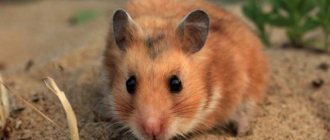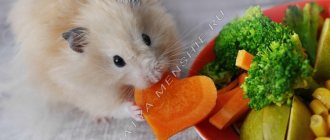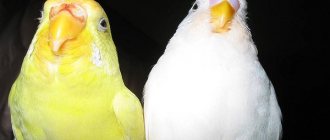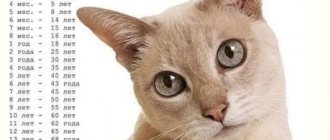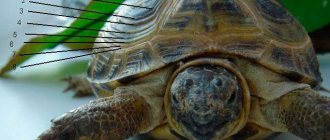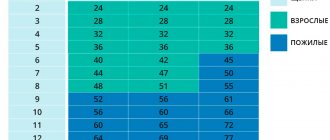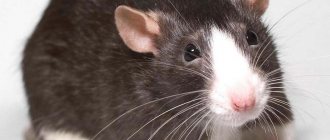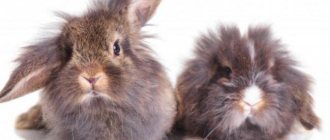- home
- Acquisition
16.07.2018
One of the most important points when purchasing any pet is determining its age. The store can sell an adult animal under the guise of a young one, which will reduce its lifespan for its new owner. Since the estimated lifespan of a hamster is 2 years, you need to be sure of the animal you choose. In order not to be deceived and not to get into an awkward situation, the buyer himself must be able to recognize the age of the hamster.
It is very difficult to determine the age of a Djungarian hamster with absolute accuracy, even for a good specialist, so they always speak approximately. Typically there are three age stages: young, adult and old. In no case is it recommended to buy a baby younger than one month, since at this age it is still too small and will have to be fed manually with a pipette and at frequent intervals.
How old do hamsters grow?
There is no clear answer to the question: “Until what age do hamsters grow?” It all depends on the breed. Hamsters are born small, about the size of a bean and weighing 3-4 grams. Cubs of small breeds (for example, Djungarian hamsters) grow for about 1-1.5 months. After this, the rodents become adults and begin to grow in width. Larger breeds (such as Syrian hamsters) take 1-2 weeks longer to grow.
IMPORTANT! It is not recommended to purchase hamsters older than 1 year, because... they are already elderly and not as active.
Age of puberty and reproduction
Puberty in hamsters occurs at the age of 1 month. In the period from 1 to 2 months, mating is not recommended, because the female is not yet mature enough: she needs time to prepare to create the next generation. It is necessary to wait until the skeleton and organs of rodents are fully formed, otherwise after premature mating they may give birth to underdeveloped offspring, and the female may eat them.
Males are able to fertilize a female after reaching three weeks of age.
The best time for the first mating is between 4 and 6 months of age. The next mating after the first can be carried out only after 2 - 3 months, because The animal needs time to restore its body after pregnancy and childbirth.
Females are able to give birth to offspring up to 1.5 years of age, and males retain reproductive function throughout their lives.
Repeated fertilization after the first in males is best done after 5 weeks, because the male may be weak for some time and not able to fertilize the female.
At the age of 20 days, hamsters can already eat protein foods
Human and hamster years: how to compare
Now let's talk about how to compare the ages of a hamster and a human. If we take the life expectancy of a human to be 60-70 years, and a hamster’s to be 2-3 years, we will get the following ratio.
- A six-month-old hamster can be equated to a 12-year-old teenager.
- A one-year-old animal is a sexually mature adult.
- From the age of 1.5 years the animal enters the aging phase.
You can extend the life of your pet hamster if you take good care of it. Follow the recommendations of experts, and the animal will delight you for a long time and will become a real long-lived hamster.
moy-homyachok.ru
How to find out how many days or years old a hamster is
The skin of newborn hamsters is hairless and red in color. As they grow, it begins to change color and turns pink.
At the age of 6-8 weeks, baby hamsters begin to squeak and ask their mother for food. Their sparse fluff turns into thicker ones.
When they reach the age of 10-12 days, they are still blind, but crawl out of their house, exploring the world around them by touch.
At the age of 15-20 days, their eyes open and the fluff changes to thicker fur. They can already eat soft protein foods (boiled eggs, cottage cheese).
30-40 days after birth, they become adults, feed on their own and make their own nest. Some individuals defend their territories.
You can determine its age by the presence of hair in the ears of a dzhungarik.
Reviews
Oleg, 34 years old
My ten year old daughter loves rodents. Whom we didn’t already have! Recently we decided to buy a light brown Syrian. The daughter is delighted. I’ll say right away that we bought a two-month-old baby, but the cage was of impressive size, so that later, when he grows up, he wouldn’t feel cramped. We feed a ready-made mixture of grains, vegetables and fruits.
Maria, 46 years old
We bought our grandson a beige boy with a small white spot on his left side. The golden hamster has been living with us for three months now. At first everything was fine, but recently he began actively gnawing on the bars in the same corner. We don't quite understand what he's trying to achieve. We read that he most likely needs a female. We'll buy it.
Alisa, 19 years old
A few weeks ago I bought a three-month-old female Far Eastern hamster. For the first few days she made virtually no sounds and was motionless. When I tried to pick her up, she began to squeak loudly and squirm. After about a week, she became bolder and began to leave her house more often, especially when she heard my voice.
sovets24.ru
Feeding
A balanced diet is important for a rodent's health. The diet is based on grain mixtures, which are sold ready-made. Along with this, they give vitamin and mineral complexes. Despite the omnivorous nature of hamsters, nutritional control must be present. They love to eat junk foods like chips or cakes. Only this will quickly damage the kidneys and liver.
Since pets hibernate during the day, they are fed 2 times - morning and evening, in small portions. Remains of food are immediately removed, especially natural products. Hamsters may experience digestive disorders from eating spoiled food.
Hamsters tend to store food supplies, so food left in a bowl will quickly be transferred to one of the corners of the cage or end up on the floor. Therefore, you need to put in as much food as the animal can eat at one time.
Products that can be fed to Syrian hamsters are presented in the table.
| Category | Diet features |
| Adults | In addition to grain mixtures, animals are fed:
You cannot feed them the following foods:
|
| Cubs aged 2 weeks to two months | Babies eat a lot and often, so it is important to establish the optimal portion size. They shouldn't be too big. Food must be exclusively fresh and of high quality. Recommended Products:
Once a day it is acceptable to give wet food intended for babies |
| Pregnant females | The expectant mother is fed more densely than ordinary hamsters. There should always be clean drinking water and fresh greens in the cage. It will be useful to pour milk sometimes. The menu is standard, but they also add fatty cottage cheese, egg whites and boiled chicken. The source of calcium will be a piece of chalk or a special tablet that is placed on the floor |
| Elderly individuals | Starting from the age of two years, the animals eat significantly less. Due to age, they become less active and lose teeth, and therefore there is a need to change their diet. Solid feed, vegetables and fruits are chopped before serving. Children's dairy-free cereals and vitamins are suitable |
In case of illness of the pet, the feeding scheme and food set are adjusted by the veterinarian. If the malaise is associated with obesity, then preference is given to dietary foods.
animalgrow.com
Dzungariki
Behavioral differences
The behavior of individuals is the most distinctive feature in determining their age. Young individuals run actively, play a lot, chew food and make squeaks.
Older individuals are calm, move little, rarely eat and often sleep.
Hair in the ear area
In newborn Djungarians, the inside of the ears is covered with white soft hairs, which thin out and disappear over time. The complete absence of fuzz on the ears indicates old age of the individual.
Eyes
In young individuals, the eyes are the same color, slightly shiny and not very protruding. If cloudiness is observed in the eyes, most likely the rodent is old or sick and will not last long.
Wool
The thicker the animal's fur, the older it is. Young individuals have a brighter, richer coat color and no bald patches.
The coat of newborn hamsters is softer and smoother. Hamsters that are 5 days old are completely hairless and will not have hair for another 2 weeks.
14 days after birth, the color becomes variegated, and the coat becomes thick and smooth. By the middle of a hamster's life, the coat will be tough. The thicker the fur, the longer the rodent lives.
Weight
Weight and size also indicate the age of the rodent.
If the hamster is more than 8 centimeters in length, then most likely it is more than 2 months old. At the age of 5-12 months, dzhungariki weigh approximately 40 g.
IMPORTANT! When purchasing a hamster, it will be enough to weigh it to determine its age. Leading veterinarians recommend purchasing an animal at the age of 5–12 weeks of life. At this age, individuals get used to the world around them and are not particularly afraid; they are able to feed on their own.
It is worth noting that the weight gain of animals stops at 4 months.
Have you ever doubted the age of a hamster?
Dark spots
Another sign of determining the age of hamsters is the presence of age spots. They are located in the thigh area and resemble small seals. The color of the spots differs from the color of the skin. The more of them on the skin, the older the individual. Females have fewer pigment spots than males. The most noticeable ones are on the stomach and genital area.
Lifespan
The average lifespan of Djungarian hamsters is 2-3 years.
It is much more difficult for them to survive in the wild. This is due to dangerous factors found in nature: attacks by predators, poor tolerance to adverse weather conditions, eating at different times. Wild hamsters live 1.5 years.
Owners of domestic Djungarian hamsters surround them with care and attention, which is why the animals have a longer lifespan. With special and good care, you can extend their life to 3.5 years.
Young Syrians have black eyes
Dwarf hamsters
A fairly common species among breeders. Dwarf hamsters do not require much effort to maintain, and care is minimal. They weigh no more than 50 grams, and their height rarely reaches 10 centimeters.
The dwarf breed includes:
- Taylor's hamster;
- Campbell's hamster;
- Roborovsky's hamster (the owner of the smallest volumes).
Several other breeds:
- Long-tailed - body length does not exceed 10 cm, 6 of which are tail;
- Taylor - carcass length 7-8 cm, weight about 10 grams.
- Campbell's hamster - can reach 12 cm.
- Radde - has a height of up to 28 cm. It can mainly be found in the wild, not a common species as an ornamental animal.
Any breed of hamster does not require much effort in cleaning or care, and even a child can monitor the comfort of the fluffy one, the only condition is regular supervision.
Weighing the fluffy: how to do it?
Hamsters are happy, active animals, and if your pet is not hand-trained, then weighing a hamster is not an easy task that requires dexterity.
To do this you will need:
- kitchen scales
- small box or container
- tasty treats
First place the container with the treat placed in it on the scales in order to subsequently subtract their weight from the total weight of the hamster. Place the fluffball in a container. This way you can easily find out your pet's weight.
Weight control is necessary: this way you can see excess weight or sudden weight loss, which may indicate health problems.
If you change the homa's diet, you also need to monitor its weight: a decrease may indicate that the food is not to its taste and the animal is starving, simply hiding it.
Before purchasing a pet, decide which breed appeals to you, based on this, choose a house and the place where it will be located.
By following simple rules - watch your weight, keep the cage clean, spend time with your fluffy, you will get a reliable friend who will delight you and love you in return for a long time.
Hamsters are wonderful animals that even a beginner can breed at home. Before you buy an animal, you need to know exactly the breed, because it depends on how much the hamster weighs. The weight and size of the pet are important. Based on the size of the pet, you should consider:
- the size of the cage you should buy;
- a set of pet entertainment (wheel, sticks) and their sizes;
- living together or living alone;
- amount of feed.
This type of hamster has long taken root in modern apartments. His appearance is very pleasant, his behavior is funny, you can watch his actions for a long time.
The hamster differs in body shape from its relatives. On the back, closer to the tail, its spine is slightly curved, so it feels like the animal has a small hump.
It is very interesting to watch such an animal when it stuffs its cheek pouches; they are very large and can stretch well.
The size of the Djungarian hamster does not exceed 10 cm. Usually these animals grow up to 6-9 cm. Height and weight depend on the conditions of detention and individual characteristics. The weight of a Djungarian hamster can reach 50 grams.
djungarian hamster
Based on these data, experts advise buying a cage measuring 30x50 cm, with fine bars. The running wheel can be purchased with a diameter of 13-17 cm.
These hamsters can be kept alone.
If future owners have chosen the Syrian breed, they need to know how much a Syrian hamster weighs, because this species is very different in size from the Djungarian. The size of an adult Syrian hamster can reach 19 cm, which is quite a large animal.
Despite its size, this hamster loves to be held, loves to attract attention and enjoys any communication.
The weight of the Syrian hamster ranges from 100 to 200 grams.
Syrian hamster
It is interesting that pets of this breed can be either short-haired or long-haired.
He is offered:
- cage 40x60 cm;
- running wheel, diameter 18 cm;
- Single accommodation.
The Siberian hamster can be found in nature; it lives in Siberia, hence its name.
They are very reminiscent of Djungarian hamsters, differing only in the color of their fur. The Siberian has a gray color, and in winter the animal’s coat becomes completely white. This is especially interesting to observe when kept at home.
The average weight of a pet reaches 40-50 grams, and these animals grow no more than 8 cm in size. To keep a Siberian hamster, a cage the same as that of a Djungarian pet is suitable.
siberian hamster
Syrian or golden hamster
Behavioral differences
Young Syrian hamsters, like the Djungarians, are active, very active, curious about the world around them, love to play or run in a wheel, and like to stay awake at night. Sometimes they can be a little aggressive. At an older age, they become calmer and more sedentary.
Hair in the ear area
When examining a hamster, you need to pay attention to the condition of the fur near its ears and in the parotid area. In young hamsters, these parts are covered with an even, thin layer of white and fluffy hair. In older individuals, the ears are almost bare, and the remaining hairs on the ears grow noticeably.
Eyes
Young Syrian hamsters have black eyes, slightly bulging and slightly shiny. In healthy hamsters, the mucous membrane of the eyelids is pink and slightly moist.
If the eyes of Syrian hamsters are very shiny, have changed color, are covered with a yellowish film, are sunken, have popped out of their sockets, are dry or very moist, and the mucous membrane of the eyelids is inflamed - this indicates old age or illness of the hamster.
Wool
Syrian hamsters come in short-haired and long-haired varieties.
Long-haired dogs can also be “satin”. Their fur has a satiny sheen.
As they age, the color of Syrian hamsters darkens.
Golden rodents have gray small ears and black bangs. They have this coat color up to 8 months from birth. After 8 months of residence, their undercoats turn gray, but the upper hairs remain golden.
Smoky-pearl colored hamsters have gray fur and beige undercoats. As they get older, their coats may lighten. This is due to a varied diet at home.
Yellow-brown rodents have a rich honey-colored coat. The yellow tint takes up 30% of the total color. A distinctive feature is that these individuals retain their coat color throughout their lives.
Young animals have soft, thick and bright fur, but after two years it becomes hard and sparse.
Weight
The weight of a newborn Syrian hamster is 2-4 grams, and an adult - 100-125 grams. Moreover, their growth in length can reach 13 - 13.5 centimeters.
Dark spots
After one year of life, Syrian hamsters develop black spots on their bodies. They may be on the left and right lower back, as well as around the genitals, or the skin may darken in one patch. These are their glands that darken and become bulging with age.
Lifespan
Syrian hamsters live on average 3 years. If a rodent is provided with good care, it can live for 4 years. Because The average life expectancy of animals is 2 years; Syrian hamsters are classified as long-livers.
Young people are always active and playful
Lifespan of a rodent
How long the animal will live largely depends on the owners themselves and appropriate care. But there are many other factors that significantly influence how many years a hamster will have to please its owners. These include:
- Genetic inheritance.
- Proper nutrition.
- Quality of care.
- Conditions of detention prior to purchase.
- Breed (variety).
Unfortunately, breeds artificially bred by humans in laboratory conditions (selection) have a shorter life expectancy and are highly susceptible to the external environment. In other words, they have low immunity, which leads to numerous diseases.
For example, if you properly balance the diet of a dzhungarik and monitor the cleanliness of his home, he will be able to live happily for up to three years. A calm environment also significantly affects the animal’s well-being.
Veterinarians recommend adopting a new animal directly from breeders. Since it is from them that you can find out all the information about the homa’s parents, as well as see the conditions of cultivation and maintenance.
Other breeds
When purchasing a hamster of any breed, you can generally rely on the above points when determining their age. The exception is such a parameter as weight. It may differ for different breeds. And factors such as behavior, fur, ears and eyes are the same for all species.
IMPORTANT! It is worth paying attention to the following factors when choosing a hamster:
- if the hamster is more than 3 months old, it will weigh more than 40 grams;
- females increase in weight up to 4 months, after which she becomes an adult and her weight does not change, which indicates her readiness to mate;
- if the animal is more than 3 months old, its length will be at least 8 centimeters;
- young individuals are always playful and active, constantly eating, males start fights and attract females to their attention, and older animals behave calmly and stay away from everyone else.
Features of the cat's life cycle
A year in the life of a cat is a long and significant period. It is equivalent to approximately four to five human years . Knowing this, it is easy to understand why cats suddenly develop arthritis, lose their vision, or stop hearing well in a fairly short period of time. A popular and erroneous method, as we wrote above, is the “seven-year” method of converting cat years into human years: one cat year is not equivalent to our seven. This is due to the fact that in the first two years the cat matures faster than in the rest. So, in the first year the cat reaches the age of 15 human years, in the second - she is already a 24-year-old person. Each subsequent year is equal to approximately 4 years of ours. After some simple calculations, we get: the age of a five-year-old cat is 36 human years (see table below). It should also be taken into account that a cat who lives on the street ages much faster, perhaps even twice as fast, than a well-groomed indoor cat.

